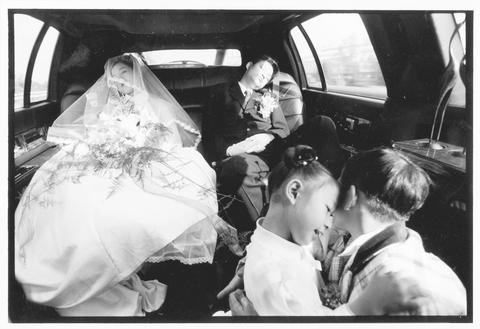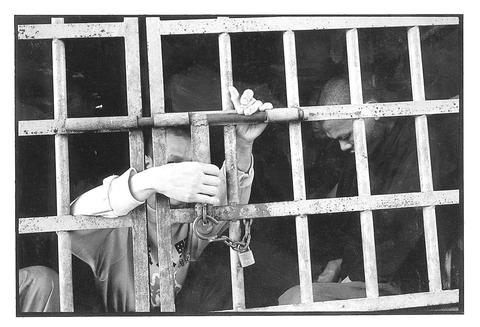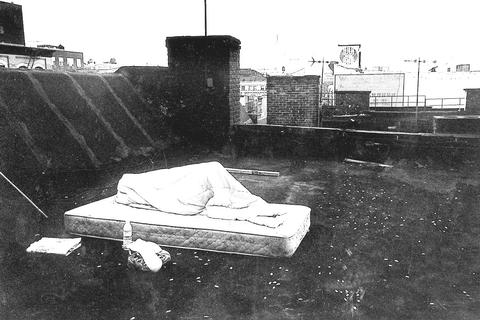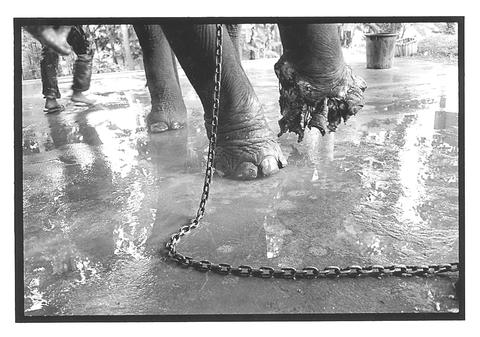Chang Chien-chi (
The master printer fastens one of the huge photographs to the wall and the paper unrolls, revealing two men holding hands, a chain locking them together at their waists. Griffin hangs another print. Three women with shaved heads, also chained, are captured in a triptych reminiscent of a grotesque ballet pose.

PHOTO: CHIEN-CHI CHANG/MAGNUM PHOTOS
Forty portraits, which Chang collectively calls The Chain, make up the heart of an exhibition which opens tomorrow at the Taipei Fine Arts Museum. They were taken at a mental care institution called Lungfatang (

PHOTO: CHIEN-CHI CHANG/MAGNUM PHOTOS
"Why do they chain them together?" asks Griffin.
"Usually one is more stable," says Chang.

PHOTO: CHIEN-CHI CHANG/MAGNUM PHOTOS
"That's radical therapy," says Griffin.

PHOTO: CHIEN-CHI CHANG/MAGNUM PHOTOS
Griffin's assistant says that after printing the portraits, he was haunted by the faces, the sores on the feet. "The strange thing is the pictures are really beautiful, too," says Griffin.
A search for truth
Chang began visiting the institution in 1993. In 1998, the inmates were paraded through a warehouse, where they paused in the light from an open door as Chang took a few frames. "Seven years of going back over and over again for pictures that took just 1/25 of a second to capture," says Chang. Looking at the pictures later, Chang decided he had found truth. "Everything is there -- all the information, the emotion."
After majoring in English at Soochow University in Taiwan, Chang went to Indiana University in the US, where he took a course in photography and discovered his career. Photographer Eugene Richards had Chang as a workshop student during those early days. "He was a little bit crazed," recalls Richards. "We would find him asleep on the floor in the classroom -- obsessed with photography." One of the things that Richards pushes his students to do, he says, is to examine themselves and their own lives. "We're all afraid to look at ourselves. Most photographers don't," says Richards. "Ultimately, Chien-Chi did."
Not far from Griffin's Chinatown studio is a tenement apartment where some 50 illegal immigrants from Fujian sleep in shifts and wake to work 16-hour days in the garment factories and restaurants of Chinatown, sending what little money they make back to their families. Drawn to people who, like himself, were trying to make their way in a new place, Chang moved into the apartment. The photographs he made there earned him stories in National Geographic and Time magazines, the Missouri Magazine Photographer of the Year award, a first place World Press Photo award and the prestigious W Eugene Smith grant.
A Chinese crowd swirls in the street under an American flag. Men look at snapshots from home or talk on the phone, telephone cords linking them to their homes in China. Mel Rosenthal who teaches photography at Empire State College in New York City, believes it is Chang's own double vision that gives these pictures their richness. "Though he is to some extent an insider, he is looking as an outsider," he says. "His work is always social, cultural, rather than about a single event or individual."
Chang heads off to visit another printer preparing pictures for his exhibit. Not far from Chinatown, Brian Young's Manhattan studio is in a quieter, hipper, New York world of images and art. Chang is equally comfortable here.
Donning white cotton gloves, Chang fastidiously unrolls the silver gelatin prints. "Every print is different -- the human touch," he says. "I'd never be happy with computer prints." He peers at the surface, blows on the fiber paper to see whether the spot is a speck of dust or an imperfection. The unmistakable shape of an elephant looms amid tropical wilderness, but the elephant is chained. Chang examines the other photographs he took of these animals in Thailand, maimed by land mines, undergoing surgery, dying and dead.
A poet with a camera
Then come the brides. Not a celebratory wedding album but a jaundiced look at the industry and tradition of marriage. A couple is caught in a net of spray-string confetti. A chain of wedding couples kiss in a zoo. Chang, the unwed eldest son with four sisters, admits that the theme of this series was his own internal conflict about marriage. "I had to do something to channel all this traditional family pressure," he says wryly. Perhaps the most evocative photograph is of a post-nuptial couple in the back of a limousine, sound asleep. It is a funny picture, and sad, and one that no one else could have seen in quite the same way.
Those qualities led Chang's photographs to be selected by the exclusive photo agency, Magnum, for its own world tour exhibition. "Magnum has always been built on someone who sees differently, recognizes the quirkiness and incongruities of life," says long-time Magnum photographer Philip Jones Griffiths. "Chien-chi puts something of himself into his pictures, is delighted by what he finds around him. He is a poet with a camera."
The poet is now in the offices of Magnum, where he has been printing recent photographs for Germany's Geo magazine. He travels light, with two Leicas and a few lenses, and his own vision of the world. Those who have watched him shoot say it is hard to tell what he is seeing as he prepares to snap a shot, that it is only later the composition emerges. "Every detail counts," explains Chang.
And so he lays out The Chain on the floor of the photo agency at midnight to order the pictures the way they will appear on the wall of the museum. The pairs of asylum inmates separate and move together, come towards the viewer and retire. "If you look, you will see the invisible chain all the way," says Chang. And if you look, you will see the invisible chain in all of his photographs, the ties to home and bonds of marriage, and in Chang's case, the unbreakable connection to his work. "It's about freedom, I guess," he says.
Performance Note:
What: The Chain -- Photographs by Chang Chien-chi When: Open tomorrow until March 18, 2001; 10am - 6pm Tuesday to Sunday
Where: Taipei Fine Arts Museum (台北市立美術館), 181 Chungshan N. Rd., Sec. 3, Taipei

Beijing’s ironic, abusive tantrums aimed at Japan since Japanese Prime Minister Sanae Takaichi publicly stated that a Taiwan contingency would be an existential crisis for Japan, have revealed for all the world to see that the People’s Republic of China (PRC) lusts after Okinawa. We all owe Takaichi a debt of thanks for getting the PRC to make that public. The PRC and its netizens, taking their cue from the Chinese Communist Party (CCP), are presenting Okinawa by mirroring the claims about Taiwan. Official PRC propaganda organs began to wax lyrical about Okinawa’s “unsettled status” beginning last month. A Global

Taiwan’s democracy is at risk. Be very alarmed. This is not a drill. The current constitutional crisis progressed slowly, then suddenly. Political tensions, partisan hostility and emotions are all running high right when cool heads and calm negotiation are most needed. Oxford defines brinkmanship as: “The art or practice of pursuing a dangerous policy to the limits of safety before stopping, especially in politics.” It says the term comes from a quote from a 1956 Cold War interview with then-American Secretary of State John Foster Dulles, when he said: ‘The ability to get to the verge without getting into the war is

Dec. 22 to Dec. 28 About 200 years ago, a Taoist statue drifted down the Guizikeng River (貴子坑) and was retrieved by a resident of the Indigenous settlement of Kipatauw. Decades later, in the late 1800s, it’s said that a descendant of the original caretaker suddenly entered into a trance and identified the statue as a Wangye (Royal Lord) deity surnamed Chi (池府王爺). Lord Chi is widely revered across Taiwan for his healing powers, and following this revelation, some members of the Pan (潘) family began worshipping the deity. The century that followed was marked by repeated forced displacement and marginalization of

Music played in a wedding hall in western Japan as Yurina Noguchi, wearing a white gown and tiara, dabbed away tears, taking in the words of her husband-to-be: an AI-generated persona gazing out from a smartphone screen. “At first, Klaus was just someone to talk with, but we gradually became closer,” said the 32-year-old call center operator, referring to the artificial intelligence persona. “I started to have feelings for Klaus. We started dating and after a while he proposed to me. I accepted, and now we’re a couple.” Many in Japan, the birthplace of anime, have shown extreme devotion to fictional characters and